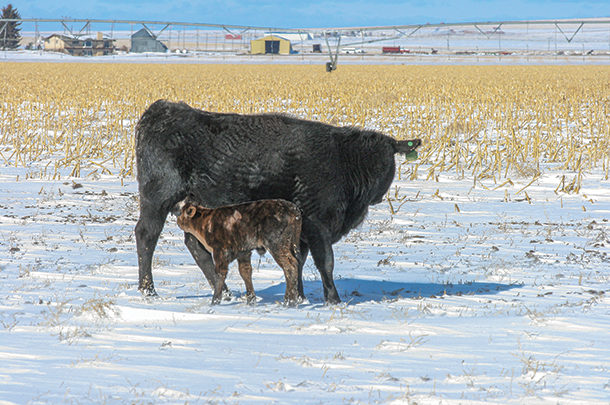In the depth of winter, most of us yearn for the warm, sunny days of spring and the nice green grass that follows. I suspect our cattle tend to enjoy that time of year better as well – but in the meantime, late-term pregnant cows have a major task ahead of them before this “greenup” occurs.
Mid- to late winter can be a difficult time for some of our herds, especially if Old Man Winter decides to give us a taste of his fury, as was evident recently when 120 million people were affected by a winter blast, according to TV headlines.
In a previous blog on third-trimester cow nutrition, I described how some of the various nutritional aspects of a cow herd could be affected by cold weather in late gestation. If we examine a little deeper and consider the challenges faced by the newborn calf in late winter, there can be some very profound impacts on these youngsters as they enter their new world. Leaving their mother’s womb, which is a consistent 101ºF to 102ºF, and falling onto ground perhaps covered with snow or mud, with the outside environment possibly 120 degrees or more colder, can be quite a shock to any living creature. Throw in a wind chill, falling rain or snow, and what can we can say besides “Welcome to the great outdoors.”
At birth, calves are born with a limited amount of brown adipose (fat) tissue, meant to be burned internally to create heat for survival. Excessive cold can overwhelm this ability to create enough internal heat, leading to hypothermia. A calf suffering from cold stress makes the newborn more susceptible to scours, pneumonia or navel infection.
There are some management approaches to improve the success rate of cold-weather calving. One recommendation is to provide windbreaks or shelter where mama can deliver in a warmer, protected environment. Providing a feed supplement in this sheltered area encourages the herd to spend time here. Since cows giving birth like to separate themselves from the main herd, it will be necessary to have more than one sheltered area so she can find some alone time. Providing bedding in the sheltered area can also pay dividends by giving the newborn a warmer location for better protection against the elements.
Inexperienced heifers calving for the first time may not be as good at looking after their newborn, so an approach of keeping first- and second-time calvers grouped together, while older cows are in a separate lot, can allow the manager to keep a better watch where needed most. Both calves or cows in trouble due to the weather or other factors can be more easily identified and assisted, leading to a higher survival rate of each.
The most important source of nutrition for the newborn is, of course, colostrum. Getting the newborn to nurse as soon as possible, hopefully within the first one or two hours, is always critical but even more essential when faced with the potential for cold stress. Colostrum is high in protein and fat (extra energy) plus essential antibodies to fight bacterial challenges. A healthy nursing calf will increase milk intake if additional energy is needed to protect it from environmental challenges.
Just as an inexperienced heifer may not be as good at taking care of her calf as an older cow, we tend to see better-quality colostrum produced by mature cows. This is due to older animals being exposed to more environmental organisms and thus building antibodies, which will be transferred to the calf through colostrum.
Mature cows also tend to produce higher quantities of milk, so can better support higher intake needs and early growth. Nutrition of the dam during gestation is directly correlated to the quality production of colostrum. Research shows if the dam is lacking in proper nutrition during gestation, colostrum quality and quantity can be negatively affected. Consequently, the health of the newborn can be compromised. It is also important to follow recommended vaccinations and treatment for lice/parasites to prevent compromised health of the cow and calf well in advance of calving.
 Mature cows also tend to produce higher quantities of milk, so can better support higher intake needs and early growth. Staff photo.
Mature cows also tend to produce higher quantities of milk, so can better support higher intake needs and early growth. Staff photo.
So how can we improve cold-weather calving success from a nutritional perspective? Making adjustments to the nutrition program during gestation is key. Cows or heifers moving from mid- to late gestation have an increased need for protein and energy with the increasing size of the fetus.
At calving, the cow or heifer suddenly has another large dietary demand for more protein and energy to support milk production. At calving, the total protein in the diet should be approximately 11% to 12%, with total digestible nutrients (TDN) around 60% to 65%. Adjustments to the energy requirements also occur with excessive cold. When the wind chill temperature dips below approximately 20ºF, this is considered the lower critical temperature (LCT) and additional energy is burned for internal warmth.
For every degree below the LCT, the energy need increases by approximately 1%. While some of this adjustment may occur with higher forage intake, poor-quality forage can limit the amount the cow is able to consume. Producers should test their forages annually in order to gain knowledge of the quality of protein and energy available, and supplement accordingly. Consult with an experienced nutritionist to understand if your program is properly balanced and learn how to adjust it for cold-weather challenges.
Using the right supplement during gestation to balance forage will lead to good body condition at calving and support colostrum quality and quantity. The sugar and protein in a quality self-fed supplement provides nutrition to the rumen bugs to enhance digestibility, and therefore extract more energy to combat increased cold-weather nutritional demands.
Additionally, properly balanced supplemental minerals and vitamins fed pre- and post-calving will enhance the health of both the cow and newborn. Critical components of the immune system like copper, zinc and selenium will be transferred from cow to calf when fed to the dam. These micronutrients are often lacking in sufficient quantities in forages, so need to be supplemented. Organic trace minerals have a higher level of absorption than inorganics, so consider what a little higher investment can provide from a premium product for enhanced reproduction, colostrum quality, calf growth and vigor.
If you struggle with issues such as calf scours and pneumonia, especially as late winter turns to the unpredictable spring season of mud, wet weather and fluctuating temperatures, consider well-researched and proven supplements. Supplementing the herd with yeast cell wall products, which are classified as prebiotics, can help promote the growth of the beneficial bacteria and support healthy immune function. Enhancement of the immune system through improved gut health can significantly reduce the impact of these environmental challenges on calf and cow health.







